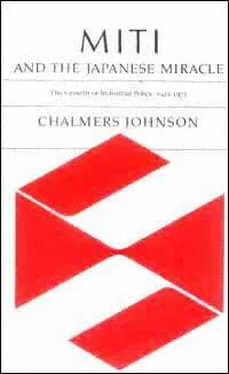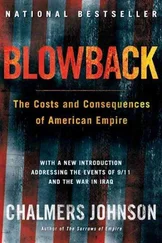Chalmers Johnson - MITI and the Japanese miracle
Здесь есть возможность читать онлайн «Chalmers Johnson - MITI and the Japanese miracle» весь текст электронной книги совершенно бесплатно (целиком полную версию без сокращений). В некоторых случаях можно слушать аудио, скачать через торрент в формате fb2 и присутствует краткое содержание. Год выпуска: 2007, Издательство: Stanford University Press, Жанр: Старинная литература, на английском языке. Описание произведения, (предисловие) а так же отзывы посетителей доступны на портале библиотеки ЛибКат.
- Название:MITI and the Japanese miracle
- Автор:
- Издательство:Stanford University Press
- Жанр:
- Год:2007
- ISBN:нет данных
- Рейтинг книги:3 / 5. Голосов: 1
-
Избранное:Добавить в избранное
- Отзывы:
-
Ваша оценка:
- 60
- 1
- 2
- 3
- 4
- 5
MITI and the Japanese miracle: краткое содержание, описание и аннотация
Предлагаем к чтению аннотацию, описание, краткое содержание или предисловие (зависит от того, что написал сам автор книги «MITI and the Japanese miracle»). Если вы не нашли необходимую информацию о книге — напишите в комментариях, мы постараемся отыскать её.
MITI and the Japanese miracle — читать онлайн бесплатно полную книгу (весь текст) целиком
Ниже представлен текст книги, разбитый по страницам. Система сохранения места последней прочитанной страницы, позволяет с удобством читать онлайн бесплатно книгу «MITI and the Japanese miracle», без необходимости каждый раз заново искать на чём Вы остановились. Поставьте закладку, и сможете в любой момент перейти на страницу, на которой закончили чтение.
Интервал:
Закладка:
(9.5)
7,830
(1.2)
1951
749,836
(100)
26,975
(3.6)
9,560
(1.3)
1952
873,942
(100)
40,308
(4.6)
8,183
(0.9)
SOURCE
: Nakamura Takafusa, "Sengo no sangyo* seisaku" (Postwar industrial policy), in Niida Hiroshi and Ono Akira, eds.,
Nihon no
sangyo
soshiki
(Japan's industrial organization), Tokyo, 1969, p. 309.
the RFB dominated the lives of all Japanese. The strong grip of the government over the economy also led to a "black mist" (
kuroi kiri
) of corruption charges that culminated in the Showa* Denko* case of 1948alleged corrupt appropriations of RFB funds for the Showa Denko Companyand the arrest of ESB Director Kurusu Takeo and others. Thus the irony that SCAP's transfer of all economic powers to the government (instead of leaving some of them in the hands of civilians as was done during the war) heightened public mistrust of the government.
In economic affairs the Katayama cabinet is known above all for two initiatives, both failures, that through their negative influence moved the discussion of economic policy to a new plane a year later. The first was the attempt to end inflation through wage and price controls. The priority production scheme was proving to be very hard on ordinary citizens since it subsidized producers but ruined households through inflation, rigged prices, and shortages.
It was the incoming director of the ESB in the Katayama cabinet, Wada Hiroo, who announced a new price system that was supposed to overcome these problems and guarantee a subsistence livelihood. He set prices at 65 times the 193436 level and wages at 27.8 times the same level, calculated on the basis of his theory that a worker's productivity had fallen to a half or a third of what it had been before the war. He also set up a guaranteed minimum wage oriented to the offi-
Page 185
cial price of rice, and he predicted that by November 1947 a family should be able to survive on it without going into debt or resorting to the black market. As it turned out, inflation persisted and Wada was ruined when, on October 11, 1947, the press made a sensation out of the discovery that a judge of the Tokyo District Court, Yamaguchi Yoshitada, had starved to death while trying to live on the official ration. Judge Yamaguchi left a diary stating that "even bad laws are the law, and I am pledged to defend the law." He had refused to buy black market rice.
49
However, the longer-range consequence of Wada's abortive attempt to control inflation was a much greater degree of agreement among economic planners that priority production had to be wedded in some way to control of the sources of inflation.
The second important but unsuccessful Katayama initiative was a proposal to nationalize the coal industry, an idea borrowed from the British Labour Party's policies of September 1946. Hirai Tomisaburo* of MCI enthusiastically drafted a state control law for the government, but it met with intense hostility in the Diet, despite MacArthur's endorsement of the plan. Mizutani Chozaburo*, MCI minister in the socialist cabinet, attempted to gain publicity for the measure by having himself photographed in a coal mine wielding a pickax and wearing only a loincloth, and he was thereafter always known as the "loincloth minister" (
fundoshi daijin
). After innumerable disruptions and fist fights in the Diet, the heavily modified Law for the Temporary State Management of the Coal Industry (Rinji Sekitan Kogyo* Kanri Ho*, number 209 of December 20, 1947, implemented on April 1, 1948) came into being. It had a three-year time limit and covered some 56 ex-zaibatsu mines. Its only concrete result was to cause a reorganization and vast expansion of the Coal Agency, which by 1950 employed some 12,000 officials. The law did not, however, serve to increase coal production beyond what the priority production system had already achieved, and it was abrogated prematurely on May 2, 1950, unlamented as the last formal effort of MCI or MITI to separate management from ownership and turn management over to the state.
50
There can be no question that priority production achieved results. Coal production for 1947 was 29.3 million tons, or 97.7 percent of the target of 30 million tons, and production was raised during 1948 to 34,790,000 tons, or about 60 percent of the highest levels ever before achieved. The increased availability of raw materials and energy influenced all other designated industries. The ESB defended priority production in its first
Economic White Paper
(July 22, 1947) with the theory that "a twofold increase in coal production leads to a fourfold increase in general manufacturing." Kudo* Shoshiro*, deputy chairman of the
Page 186
RFB, has written, ''The size of the RFB loans was foolhardy, but by the time the Dodge Line was promulgated, Japan's industrial facilities had been 80 percent restored." Moreover, according to Ikeda Hayato the RFB saw all but 2.9 percent of its loans repaid, although the RFB's successor, the Development Bank, puts the RFB's recovery rate at only 25 percent on plant and equipment loans and 78 percent on operating subsidies. Whatever the case, Ikeda concludes, "It is not right to deny the significant role that the RFB played in the recovery of Japan's postwar economy. . . . Loans were effective to a considerable degree. It is fair to say that the RFB accomplished its purposes."
51
Although no Japanese official doubts that the RFB inflation inflicted enormous hardships on the people and that it ultimately had to be stopped, priority production had an important effect on later bureaucratic attitudes as a precedent for bolder rather than more cautious, fiscally responsible courses of action. It also intensified the nationalistic attitudes of MITI officials, since the policy had been executed in the teeth of SCAP's disapproval.
52
There can also be no question that the actual institutions of priority productionthe RFB, the Supply and Demand Control Law, the ESB, and the Coal Agencywere recreations of Japan's wartime state apparatus for the economy. RFB financing was copied directly from the wartime policies of the Ministry of Finance and the Bank of Japan. The Supply and Demand Law was, if anything, stronger than any wartime law, since it gave the state control over all commodities, not just over trade. The ESB duplicated the CPB's functions and techniques, and employed many of its personnel. And the Coal Agency was the old Fuel Bureau, reborn without its seconded military officers. The creation of the ESB and the enactment of the Supply and Demand Law also forced the reorganization of MCI on November 9, 1946, into vertical bureaus for each industry, just as the creation of the CPB and its materials mobilization planning had done in 1939. As Jerome Cohen noted at the end of his study of the wartime economy, "The wartime control system with its vestiges of cartel domination was abolished, but the substitute allocation system had a very familiar appearance."
53
The obvious flaw in priority production was its effect on inflation, but an equally serious problem was the fact that it was carried out in the hothouse atmosphere of a blockaded economy. As the indices of economic activity for 1949 and 1950 indicate (see Table 13), great progress had been made toward the restoration of prewar levelsexcept in one area, foreign trade. The raw materials of Japanese industry, particularly raw cotton for the textile industry, plus petroleum and
Page 187
TABLE
13
Indices of Economic Activity, 1949 and 1950
(193436 = 100)
Category
1949
1950
Real national income
82
97
Mining and manufacturing
Читать дальшеИнтервал:
Закладка:
Похожие книги на «MITI and the Japanese miracle»
Представляем Вашему вниманию похожие книги на «MITI and the Japanese miracle» списком для выбора. Мы отобрали схожую по названию и смыслу литературу в надежде предоставить читателям больше вариантов отыскать новые, интересные, ещё непрочитанные произведения.
Обсуждение, отзывы о книге «MITI and the Japanese miracle» и просто собственные мнения читателей. Оставьте ваши комментарии, напишите, что Вы думаете о произведении, его смысле или главных героях. Укажите что конкретно понравилось, а что нет, и почему Вы так считаете.












